15 Safe Exercises For A Sprained Ankle And Precautions To Take
Stretching and strengthening the ankle muscles is the key to preventing this painful injury.

Image: Shutterstock
Strengthening and mobility exercises for a sprained ankle are helpful if you have gotten this injury more than once. Of course, you should first ice and wrap a crepe bandage around the sprained ankle to reduce the pain. Let the swelling and pain subside before you start doing ankle strengthening exercises. Sports chiropractor Brett Edmunds says, “Exercises for ankle sprains help rehabilitate the joint by ensuring that th e muscles and ligaments surrounding the injury are appropriately strengthened and stretched again.” Board-certified orthopedic surgeon Dr. Mark Slabaugh reiterates, “Exercises are typically started as soon as the swelling and pain in the ankle allow. The sooner exercises can be started, the better.”

However, newer evidence suggests that early movement is better than rest. Walking and doing simple strengthening exercises are safe and recommended if the person can tolerate the activity without significantly increased irritation (1). if the person is comfortable enough he/she can start doing ankle range of motion exercises for more mobility and flexibility.
You can start exercise therapy for minor ankle injuries after three days. For serious injuries, let the inflammation subside. Use the RICE (Rest, Ice, Compress, Elevate) method and consult a doctor. You should see your doctor or physical therapist if the sprain is severe. In many cases, it is appropriate to start exercise even on the same day or the day after the injury. Take your doctor’s permission before starting exercises for ankle rehabilitation. Once you are ready, do the following 15 safe ankle exercises to heal a sprain. Read on for advice from industry experts as well.
 Workout Blueprint: Exercises For Sprained Ankle
Workout Blueprint: Exercises For Sprained Ankle- Frequency: 2-3 times a week
- Benefits: aid healing, and improve stability, flexibility and strength in the affected area.
- Equipment Needed: Foam roller, therapy band, and a chair.
- Space Required: Small are
- Assistance Required: Yes, certain exercises do require assistance
- Who Should Avoid: Anyone with an acute ankle injury, mobility issues, or ankle pain and inflammation should check with their healthcare professionals first.
In This Article
Understanding Ankle Sprains
Ankle sprains, a common injury, occur when the ligaments supporting the ankle get overextended or torn. Sudden twists or collisions, sports activities, accidental falls, and walking on uneven surfaces are common triggers that can cause unexpected ankle stress. It’s important to be cautious and aware of these triggers to prevent such injuries.
The majority of sprains fall into one of three grades, such as Grade I (mild), in which the ligaments are only minimally strained; Grade II (moderate), in which there are partial tears; or Grade III (severe), in which the ligament is ruptured.
Understanding the type and grade of your ankle sprain is crucial. It empowers you to select safe and effective exercises that can restore mobility and stability. The following exercises for sprained ankles are designed to help you on your road to recovery. Keep reading to learn more.
15 Safe Exercises For Sprained Ankle (With Pictures)
Ankle Warm-Up ABCs
A sprained ankle is difficult for anyone who is into a regular fitness routine, as it can stop you from doing many of your everyday exercises. There are various home remedies to cure sprained ankle that you can know about before entering your exercise routine again. Till then, you may try some exercises that don’t deteriorate your sprained ankle situation. You can sit and do certain exercises to keep up with your daily routine. Before exercising, sit on a chair and warm up the ankles for 3-5 minutes. Lift your affected leg off the floor and trace the letters A, B, and C with your foot. Do this slowly and in a controlled motion.
1. Therapy Band Ankle Flexion
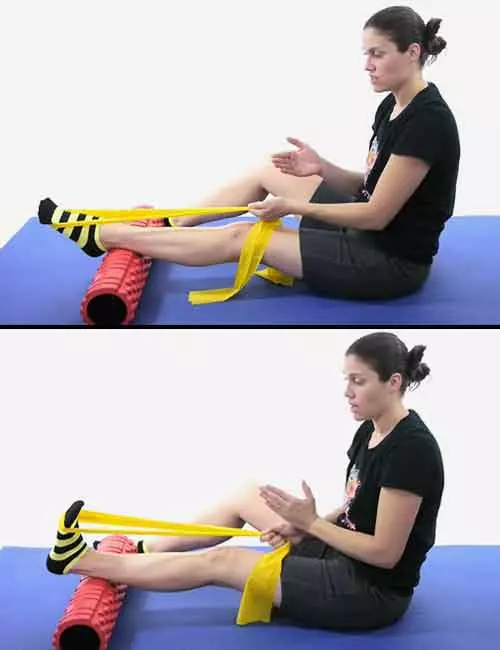
This exercise enhances ankle flexibility and builds strength, both essential for a successful recovery. It also helps in improving the range of motion.
How To Do
- Sit on a mat and place the affected foot on a foam roller or a rolled towel underneath your ankle.
- Anchor a therapy band with the ball of your foot.
- Hold the therapy band such that you get an adequate amount of resistance. Start with lower resistance.
- Point your toe forward and stretch it.
- Flex your foot towards you to stretch the calf muscle.
- Do ankle sprain exercises 10-15 times slowly and in a controlled motion.
2. Ankle Diagonal Flexion (PNF Movement)
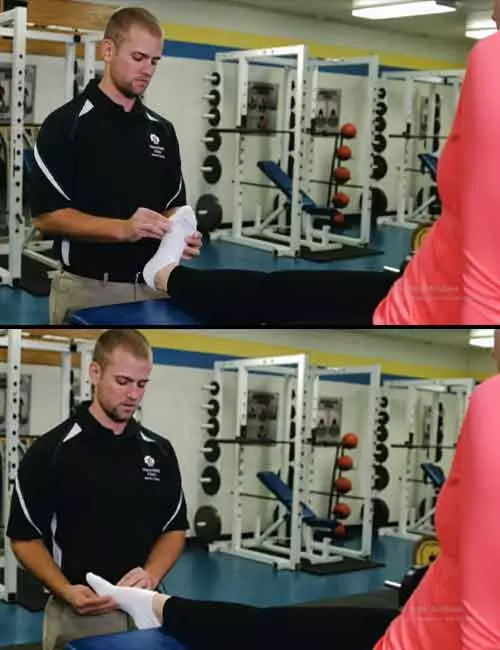
This activity targets several ankle ligaments and muscles, increasing flexibility, improving balance and strength, and strengthening neuromuscular coordination.
How To Do
- Sit on the bed and extend the leg so that the affected ankle hangs at the edge. If you sit on a mat, use a rolled towel, exercise block, or foam roller to elevate your foot.
- Place your hands on the bed for support.
- Point your toe diagonally down. If it is the right ankle, point diagonally left and vice versa.
- Flex your foot diagonally up towards you.
- Repeat the movements 10-15 times.
3. Therapy Band Ankle Eversion
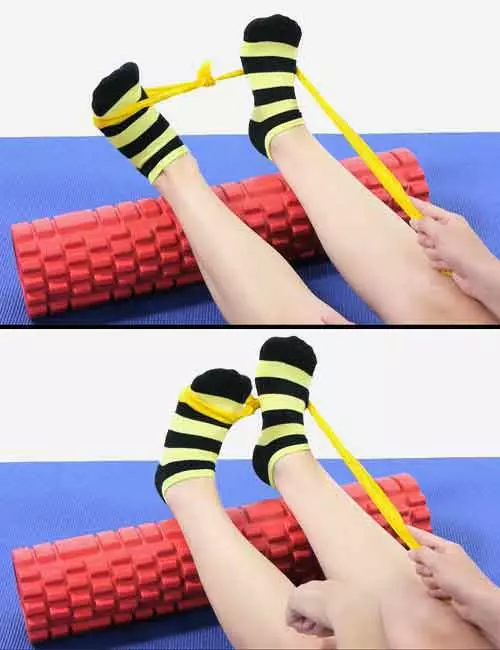
It increases stability and lowers the chance of recurrent sprains by strengthening the outer ankle muscles.
How To Do
- Sit on a mat, extend the legs, and place a foam roller or a rolled tower underneath your ankle.
- Tie a loop at the end of a therapy band.
- Put your affected leg through the loop and secure it around the ball of your foot.
- Anchor the other end of the therapy band around the other foot, as shown in the image. This is the starting position.
- Keep the resistance band fairly tight.
- Move the affected foot out to the side.
- Return to the starting position.
- Do this 10-15 times.
4. Therapy Band Ankle Inversion

It targets the inner ankle muscles, helping to strengthen and stabilize the ankle joint. This exercise is beneficial for restoring balance and preventing re-injury.
How To Do
- Sit on a mat, extend the legs, and put a foam roller or a rolled tower underneath your ankle.
- Tie a loop at the end of a therapy band.
- Put your affected leg through the loop and secure the band around the ball of your foot.
- Place the affected foot over the other foot.
- Anchor the band to the curve of the other foot, as shown in the image. This is the starting position.
- Move your affected foot away from the other foot, and bring it back.
- Do this 10-15 times.
5. Ankle Circles
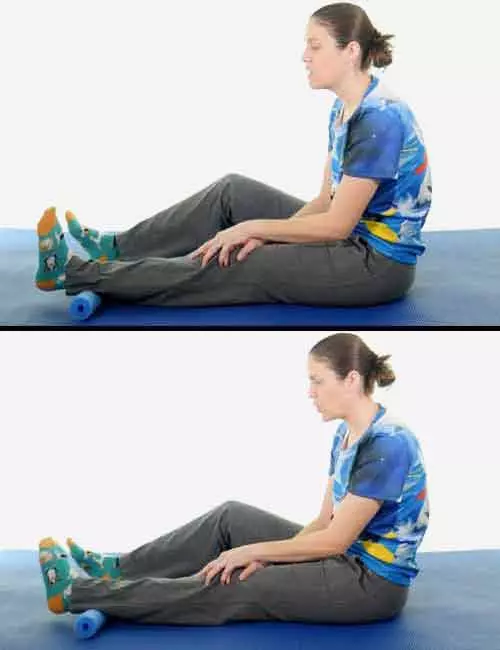
Ankle circles increase blood flow and joint mobility, which helps to shorten recovery times and lessen stiffness.
How To Do
- Sit on a mat and extend the legs.
- Place a rolled towel or a foam roller underneath the ankle.
- Rotate your foot clockwise and anti-clockwise.
- Do this 10 times.
6. Seated Ankle Mobility Exercise
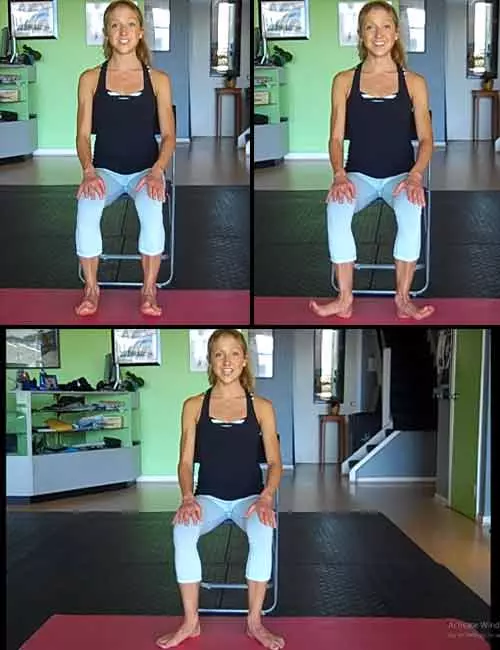
This exercise helps reduce stiffness and restore mobility in the affected area during recovery.
How To Do
- Sit on a chair. Keep your spine straight and feet flat on the floor.
- You may hold the sides of the chair for support.
- Press your heels against the floor and lift your toes.
- Rotate both feet sideways and place them back on the floor.
- Lift them again, rotate inward, and place them back on the floor.
- Do the ankle mobility exercises 10-15 times.
7. Towel Crunches
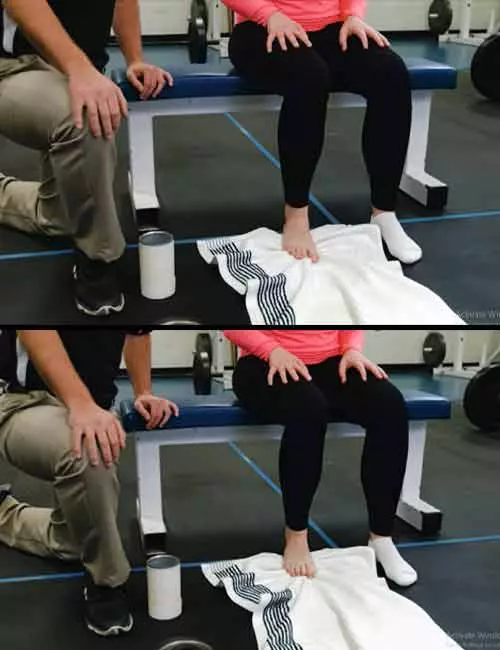
This exercise works the foot’s intrinsic muscles, which are important for improved movement and control while the injury heals.
How To Do
- Spread a hand towel on the floor.
- Sit on a chair near the towel and place the affected foot on it.
- Keep the heel pressed to the floor.
- Curl your toe to scoop in the towel with the arch and pull it towards you.
- Smooth the towel and repeat 5-10 times.
8. Ankle Isometric Exercise
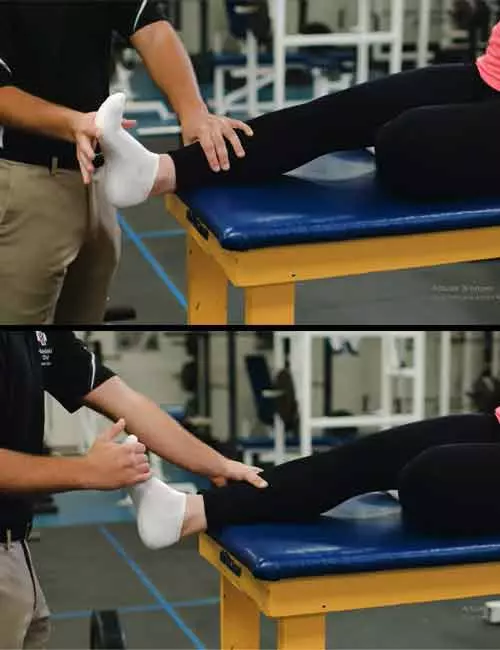
Ankle isometric exercises are helpful in the early phases of recovery because they increase ankle strength without causing joint movement.
How To Do
- Sit on the bed and extend the affected leg so that the foot is at the edge.
- The therapist will place their hand on the sole and ask you to press your foot.
- Press your foot inward while the therapist pushes against the resistance to prevent your foot from pointing down.
- Hold this for 10-20 seconds.
- Press your foot outward while the therapist pushes against the resistance to prevent flexing.
- Hold this for 10-20 seconds.
9. Supported Heel And Toe Raises

This exercise helps strengthen the calf muscles and improve balance, both of which are important for ankle recovery.
How To Do
- Stand behind a chair or a table.
- Hold the backrest or the table’s edge. Keep the feet flat on the floor, spine straight, and look forward. This is the starting position.
- Press your heels against the floor and lift the toes off the floor.
- Place your toes back on the floor and lift your heels off the floor.
- Do this 10-15 times.
10. Seated Toe Taps
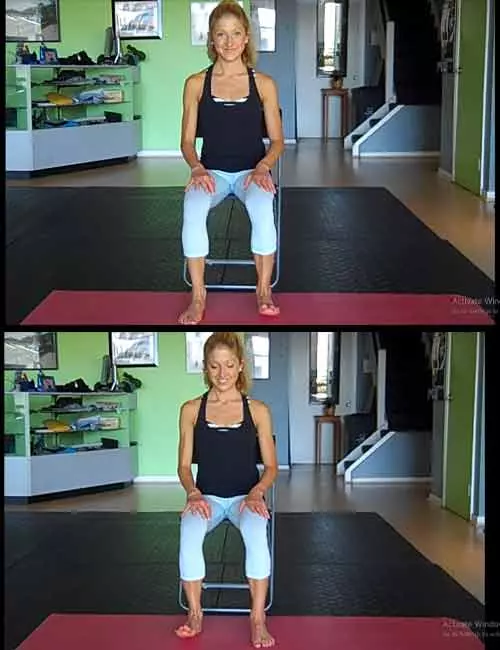
This workout improves blood circulation and coordination, both of which are critical for the healing process.
How To Do
- Sit on a chair with the spine straight, roll the shoulders back, and keep the feet flat on the floor.
- Press the right heel to the floor and lift the toe.
- Place it down. Repeat with the other foot.
- Alternate between right and left foot.
- Do this 15-20 times.
11. Sit To Stand
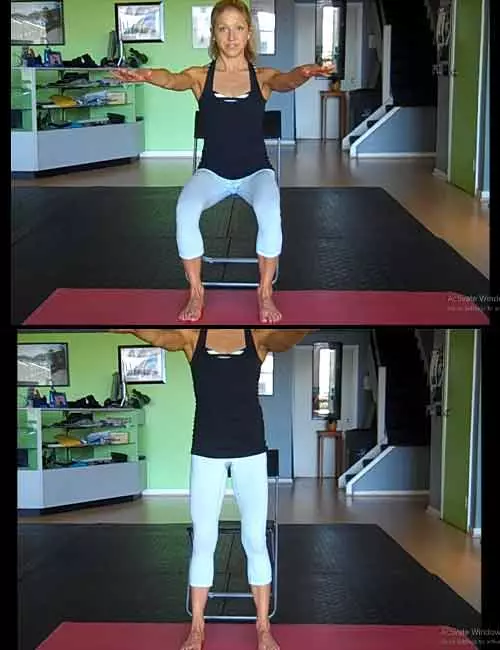
This practical workout enhances balance, coordination, and leg strength. The ankle’s surrounding muscles are also worked, which aids in stability and the healing process.
How To Do
- Sit on a chair, keep the spine straight, legs shoulder-width apart, feet flat on the floor, and roll the shoulders back.
- Extend your hands. This is the starting position.
- Press your feet against the floor, stand up and sit down.
- Do this 10-15 times.
12. Achilles Stretch
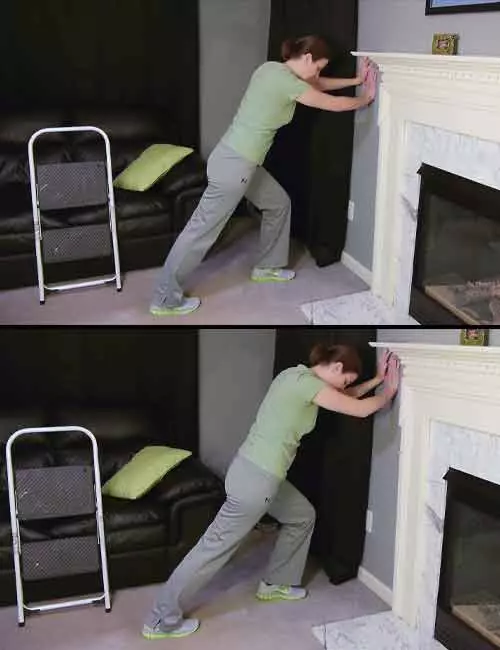
It aids in increasing calf muscle and Achilles tendon flexibility, essential for lowering stress and avoiding more injuries while recovering.
How To Do
- Stand facing a wall. Take two steps back and place both your hands on the wall.
- Place the affected foot behind the other one and extend it.
- Push the knee of the front leg towards the wall.
- Stretch the Achilles tendon without lifting the heel of the affected leg.
- Do this 10 times.
13. Squats

How To Do
- Stand with your feet shoulder-width apart and hold the backrest of a chair for support.
- Push your hips back, flex your knees, and lower your body into a sitting position. Hold for a few seconds and get up.
- The knees should not overshoot the toes. Keep your heels pressed to the floor.
- Do this 5 times.
- Place the other foot behind the affected foot and squat.
- Do this 5 times.
14. Tandem Stance
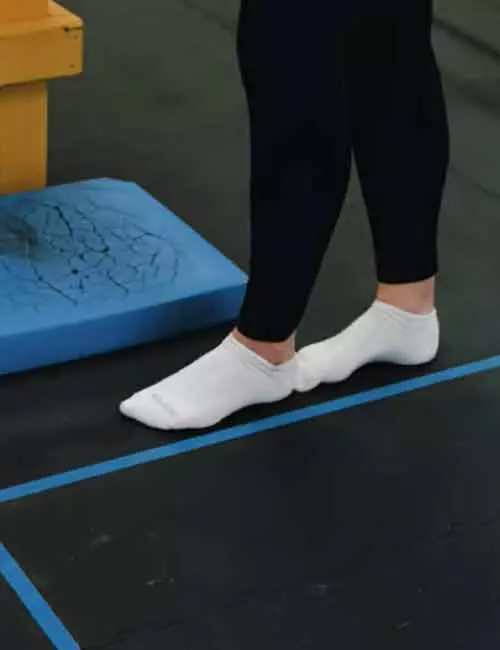
This exercise improves the sense of balance and strengthens the stabilizing muscles of the ankle.
How To Do
- Hold the backrest of a chair or the table’s edge for support. Keep the legs hip-width apart, and feet flat on the floor.
- Place your right foot in front of the left.
- Hold this tandem stance for 10 counts.
- If you are comfortable, take your hands off the backrest or the table.
- You may also close your eyes.
- Switch legs and repeat.
- Repeat this 5 times.
15. Single Leg Balance
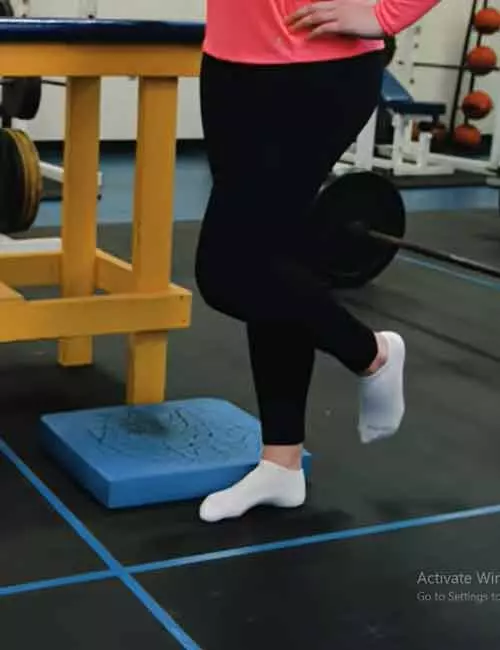
This exercise helps to improve the sense of balance, strengthen the muscles in the ankle and lower leg, and increase general stability.
How To Do
- Hold a table for support, keep the legs hip-width apart, and feet flat on the floor, and place the other hand on your waist.
- Lift the unaffected leg off the floor.
- Hold for 5-10 counts.
Note:
Do not do these ankle proprioception exercises, if the ankle bone hurts.
You can do these 15 ankle strengthening exercises if your doctor permits. Although these are amazing ankle physical therapy exercises, it’s best to listen to your body before performing them. So, how do you understand when the right time is? Let’s hear it from the experts below.
Key Takeaways
- Ankle warm-up ABCS, ankle diagonal flexion (PNF movement), therapy band ankle eversion, and therapy band ankle inversion are safe exercises for sprained ankles.
- Avoid doing ankle balance exercises like single-leg balance if your ankle bone hurts.
- Increase your strength, get your balance, and don’t forget to stretch if you have sprained your ankle.
When To Start Exercising
The doctor will let you know after examining the extent of the injury. Licensed chiropractor Dr. Veera Gupta says, “It just depends on the extent of how badly you injured your ankle as to when rehab begins. For example, a grade three sprain of a ligament is a full tear, and that will take a different amount of time versus a grade one, which is just a partial tear. The name of the game is to get the swelling down first.”
It is important to note that it’s not necessary to wait for the swelling to go down before you start exercising, you can also do ankle flexibility exercises for a headstart. Particularly in the case of a more severe sprain, it could take months for the swelling to really go down. This is why early exercise within the first couple of days is still recommended.
 Quick Tip
Quick TipIn other words, you need to give your foot complete rest before doing your ankle rehab exercises. Does that mean you should refrain from walking? What are the experts saying?
Can I Walk If I Have A Sprained Ankle?
No, not until the pain subsides. Walking may seem to be a low-impact exercise and harmless. However, it can worsen the inflammation if you start walking before the ankle recovers from the injury.
In any case, if the pain is tolerable, and walking does not exacerbate it, it may be alright. Start with small amounts of walking and then increase over time. If it constantly worsens your symptoms, then you might need crutches and some rest.
“If the ankle is a grade 1 sprain, walking is typically started right away; grade 2 usually takes within 3-5 days, and grade 3 ankle sprains can be more prolonged, depending on the severity of the swelling,” confirms board-certified orthopedic surgeon Dr. Mark Slabaugh.
Stephanie Niño, PT, DPT, says, “Depending on the severity of the ankle sprain, patients are typically advised to avoid strenuous activity during the treatment and recovery period, as there is a high occurrence of re-injury or the development of chronic problems.” She advises avoiding walking if you are unable to bear the body weight. Sports chiropractor Brett Edmunds urges, “Use crutches when you need to walk on your sprained ankle and wear ankle braces.”
Apart from letting the swelling or inflammation go down, you must take a few safety precautions to prevent falls and further aggravating the injury. Scroll down to get expert insights.
Safety Precautions To Take
Stephanie Niño, PT, DPT, says, “Some people are predisposed to ankle sprains and strains. For example, people with a hindfoot varus in which the general nature or posture of the heels is slightly turned toward the inside, it is easier to roll or twist the ankle. In addition, people who have had a severe sprain in the past or have weak ankle or foot muscles may be predisposed to sprains.” She recommends taking the following precautions:
- Don’t Forget To Stretch: The Achilles tendon and calf muscles support the ankles. Stretching these muscles can improve your ankle mobility, flexibility, and range of motion. Stretch them at least once a day to prevent stiffness.
- Increase Your Strength: Most of us tend to focus on strengthing our upper body and legs. However, it is equally important to strengthen the ankle joints and the surrounding muscles. Exercises like foot rolls, standing heel raises, squat jumps, and soleus presses can help strengthen the ankle muscles.
- Get Your Balance: Good balance is crucial for keeping the ankles pain-free. You need ankle stability exercises for Improving your balance, which will help in reducing the chances of accidental falls and enhancing muscle memory to keep you upright and stable. Also, if your ankle bone hurts, stay away from balance exercises like single-leg balance. However, knowing about different balance exercises can help you further find the one that works best for you during testing times like this.
 Quick Tip
Quick TipInfographic: The RICE Method For Ankle Sprain
While the exercises mentioned here can help restore your ankle’s range of motion, strength, and flexibility, it is important not to overdo them and let the sprain heal at its own pace. Attending to the sprain immediately with the RICE method can help accelerate the healing process. Check the infographic to learn how.
Some thing wrong with infographic shortcode. please verify shortcode syntax
Exercises for a sprained ankle help rehabilitate this joint. However, you must not do the exercises listed above immediately after spraining your ankle. Instead, wait for the swelling to subside and get a go-ahead from the doctor for rehabilitation. Moreover, do not walk until the pain reduces. Otherwise, you may worsen your injury. The waiting period before the exercise differs depending on the extent of the injury, so consult a doctor immediately for an examination. When you are cleared for the exercises that help strengthen the ankle and foot muscles, ligaments, and tendons, do not do them without warming up first. Ideally, you will be able to walk without pain within 4-6 weeks.
Frequently Asked Questions
What types of exercises should I do for different grades of ankle sprains?
For Grade I sprains, focus on mild range-of-motion exercises, such as ankle pumps and circles. For Grade II sprains, combine strengthening and mobility exercises, including supported heel lifts and therapy band flexion. Rest is necessary for Grade III sprains, but if a medical expert gives permission, exercises like sitting mobility and ankle isometrics can be gradually resumed. However, before starting any exercise, it is crucial to take medical advice to avoid any repercussions later.
Should you massage a sprained ankle?
Massaging a sprained ankle may provide you some relief. But it is always better to consult a doctor before doing it.
Should I wrap a sprained ankle at night?
No. You may wrap or bandage your ankle in the morning to relieve swelling and take it off at night.
Can I do cardiovascular exercises with a sprained ankle?
Cardiovascular exercise is generally not advised if you have a sprained ankle because it might make the injury worse and slow the healing process. On the other hand, low-impact exercises such as swimming, cycling, and utilizing an elliptical machine may be more appropriate. These types of exercises can be beneficial for the heart without placing too much strain on the ankle joint. However, before beginning any exercise program, consult with a healthcare professional or a physical therapist.
What should I do if I feel pain during or after exercising my sprained ankle?
If you feel pain while exercising your sprained ankle, stop immediately and rest the affected area. Exercising in pain can aggravate the injury and slow the healing process. If the ankle is still swollen and inflamed after being rested, you might try applying ice to the area. In order to reduce swelling and encourage healing, compression bandages and elevating the ankle above the heart are also helpful.
Can I participate in sports or high-impact activities with a sprained ankle?
No, participating in sports or high-impact activities with a sprained ankle is generally not recommended as it can worsen the injury and delay the healing process.
Are there any exercises I should avoid with a sprained ankle?
When you have a sprained ankle, there are certain exercises you should avoid to prevent further injury or pain. High-impact exercises such as running, jumping, or sudden changes in direction should be avoided as they put excessive stress on the ankle joint. Additionally, exercises that involve balancing on one foot or standing on your tiptoes can also put strain on the ankle and should be avoided.
Illustration: Safe Exercises For A Sprained Ankle And Precautions To Take

Image: Dall·E/StyleCraze Design Team
Learn the best exercises to help you recover from a sprained ankle. Tune into this insightful video to get back on your feet faster and stronger.
References
Articles on StyleCraze are backed by verified information from peer-reviewed and academic research papers, reputed organizations, research institutions, and medical associations to ensure accuracy and relevance. Read our editorial policy to learn more.
- Effect of accelerated rehabilitation on function after ankle sprain: randomised controlled trial
https://www.bmj.com/content/340/bmj.c1964
Read full bio of Dr. Nathan Kadlecek
Read full bio of Ravi Teja Tadimalla
Read full bio of Payal Karnik








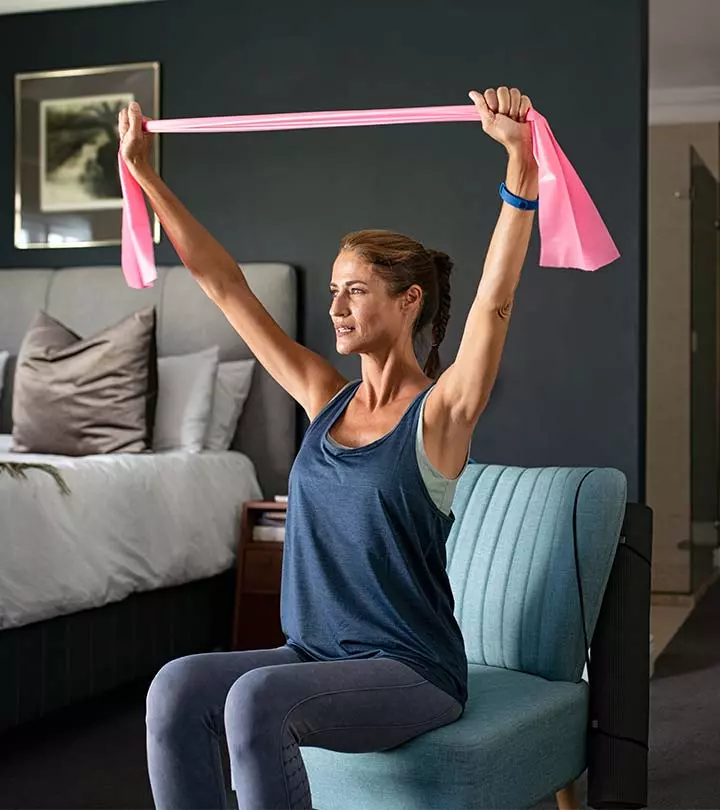

















Community Experiences
Join the conversation and become a part of our empowering community! Share your stories, experiences, and insights to connect with other beauty, lifestyle, and health enthusiasts.